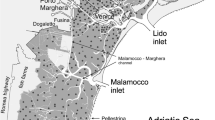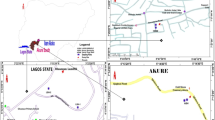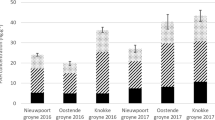Abstract
Mono-ortho and non-ortho coplanar polychlorinated biphenyls (PCBs) were analyzed in Aroclors®, seals, and humans by graphitized carbon, a recently developed HPLC method (Hong et al. 1992b) and high-resolution gas chromatography with electron capture detection (HRGC/ECD). The concentration data were multiplied by potency factors derived from aryl hydrocarbon hydroxylase (AHH) induction to give 2,3,7,8-tetrachlorodibenzo-p-dioxin (TCDD) equivalents. The ability to separate coplanar PCBs from the majority of PCBs has allowed the use of TCDD toxicity equivalence to compare the relative dioxin-like potency of PCB residues in the complex mixtures. The most active mixtures, Aroclors® 1254, 1248, and 1242, contained 42–54% by weight of chlorine. The results demonstrate that the apparent dioxin-like potency of PCB residues in Aroclors®, seals, and humans is dominated by three congeners, 3,3′,4,4′-tetra-, 2,3,3′,4,4′-, and 3,3′,4,4′,5-pen-tachlorobiphenyl (IUPAC nos. 77, 105, 126).
Similar content being viewed by others
References
Brunström B (1990) Mono-ortho-chlorinated chlorobiphenyls: Toxicity and induction of 7-ethoxyresorufin O-deethylase (EROD) activity in chick embryos. Arch Toxicol 64:188–192
Brunström B, Andersson L (1988) Toxicity and 7-ethoxyresorufin O-deethylase-inducing potency of coplanar polychlorinated biphenyls (PCBs) in chick embryos. Arch Toxicol 62:263–266
Bryan AM, Stone WB, Olaffson PG (1987) Disposition of toxic PCB congeners in snapping turtle eggs: expressed as toxic equivalents of TCDD. Bull Environ Contam Toxicol 39:791–796
Bush B, Streeter RW, Sloan RJ (1989) Polychlorobiphenyl (PCB) congeners in striped bass (Morone saxatilis) from marine and estuarine waters of New York State determined by capillary gas chromatography. Arch Environ Contam Toxicol 19:49–61
Clarke JU (1986) Structure-activity relationships in PCBs: Use of principal components analysis to predict inducers of mixed-function oxidase activity. Chemosphere 15(3):275–287
Hong CS, Bush B, Xiao J (1992a) Coplanar PCBs in fish and mussels from marine and estuarine waters of New York State. Ecotoxicol Environ Safety 23:118–131
Hong CS, Bush B, Xiao J, Fitzgerald E (1992b) Isolation and determination of mono-ortho and non-ortho substituted PCBs (coplanar PCBs) in human milk by HPLC porous graphitic carbon and GC/ECD. Chemosphere 24(4):465–473
Huckins JN, Schwartz TR, Petty JD, Smith LM (1988) Determination, fate, and potential significance of PCBs in fish and sediment samples with emphasis on selected AHH-inducing congeners. Chemosphere 17:1995–2016
Huckins JN, Stalling DL, Petty JD (1980) Carbon-foam chromatographic separation of non-o, o′-chlorine substituted PCBs from Aroclor® mixtures. J Assoc Offic Anal Chem 63:750–755
Kannan N, Tanabe S, Ono M, Tatsukawa R (1989) Critical evaluation of polychlorinated biphenyl toxicity in terrestrial and marine mammals: Increasing impact of non-ortho and mono-ortho coplanar polychlorinated biphenyls from land to ocean. Arch Environ Contam Toxicol 18:850–857
Kannan N, Tanabe S, Tatsukawa R (1988a) Potentially hazardous residues of non-ortho chlorine substituted coplanar PCBs in human adipose tissue. Arch Environ Contam Tox 43(1):11–14
—, —, — (1988b) Toxic potential of non-ortho and mono-ortho coplanar PCBs in commercial PCB preparations, 2,3,7,8-TCDD toxicity equivalence factor approach. Bull Environ Contam Toxicol 41:267–276
Kannan N, Tanabe S, Wakimoto T, Tatsukawa R (1987a) A simple method for determining non-ortho substituted PCBs in Kanechlors®, Aroclors®, and environmental samples. Chemosphere 16:1631–1634
—, —, —, — (1987b) Coplanar polychlorinated biphenyls in Aroclor® and Kanechlor® mixtures. J Assoc Offic Anal Chem 70:451–454
Kubiak TJ, Harris JH, Smith LM, Schwartz TR, Stalling DL, Trick JA, Sileo L, Docherty DE, Erdman TC (1989) Microcontaminants and reproductive impairment of the Forster's tern on Green Bay, Lake Michigan—1983. Arch Environ Contam Toxicol 18:706–727
Leece B, Denomme MA, Towner R, Li SMA, Safe S (1985) Polychlorinated biphenyls: Correlation between in vivo and in vitro quantitative structure-activity relationships (QSARs). J Toxicol Environ Health 16:379
Mes J, Weber D (1989) Non-ortho chlorine substituted coplanar polychlorinated biphenyl congeners in Canadian adipose tissue, breast milk and fatty foods. Chemosphere 19:1357–1365
Niimi AJ, Oliver BG (1989) Assessment of relative toxicity of chlorinated dibenzo-p-dioxins, dibenzofurans, and biphenyls in Lake Ontario salmonids to mammalian systems using toxic equivalent factors (TEF). Chemosphere 18:1413–1423
Parkinson A, Safe S (1981) Aryl hydrocarbon hydroxylase induction and its relationship to the toxicity of halogenated aryl hydrocarbons. Toxicol Environ Chem Rev 4:1–46
Poland A, Greenlee WF, Kende AS (1979) Studies on the mechanism of toxicity of the chlorinated dibenzo-p-dioxins and related compounds. Ann NY Acad Sci 320:214
Safe S (1990) Poplychlorinated biphenyls (PCBs), dibenzo-p-dioxins (PCDDs), dibenzofurans (PCDFs), and related compounds: Environmental and mechanistic considerations which support the development of toxic equivalency factors (TEFs). CRC Crit Rev Toxicol 21(1):51–88
— (1987) Determination of 2,3,7,8-TCDD toxic equivalent factors (TEFs): Support for the use of the in vitro AHH induction assay. Chemosphere 16:791–802
— (1984) Polychlorinated biphenyls (PCBs) and polybrominated biphenyls (PBBs): Biochemistry, toxicology and mechanism of action. CRC Crit Rev Toxicol 13:319–395
Safe S, Bandiera S, Sawyer T, Robertson L, Safe L, Parkinson A, Thomas PE, Ryan DE, Reik LM, Levin W, Denomme MA, Fujita T (1985) PCBs: Structure-function relationships and mechanism of action. Environ Health Perspect 60:47–56
Safe S, Hutzinger O (1987) Polychlorinated biphenyls (PCBs): Mammalian and environmental toxicology, Environmental toxin series 1. Springer-Verlag, NY, pp 49–75
Sawyer TW, Safe S (1982) PCB isomers and congeners: Induction of aryl hydrocarbon hydroxylase and ethoxyresorufin O-deethylase enzyme activities in rat hepatoma cells. Toxicology Letters 13:87–94
Sawyer TW, Vatcher AD, Safe S (1984) Comparative aryl hydrocarbon hydroxylase induction activities of commercial PCBs in Wistar rats and rat hepatoma H-4-II E cells in culture. Chemosphere 13(7):695–701
Smith LM, Schwartz TR, Feltz K (1990) Determination and occurrence of AHH-active polychlorinated biphenyls, 2,3,7,8-tetrachloro-p-dioxin and 2,3,7,8-tetrachlorodibenzofuran in Lake Michigan sediment and biota. The question of their relative toxicological significance. Chemosphere 21(9):1063–1085
Tanabe S (1988) PCB problems in the future: foresight from current knowledge. Environ Pollut 50:5–28
Tanabe S, Kannan N, Subramanian A, Watanabe S, Tatsukawa R (1987) Highly toxic coplanar PCBs: occurrence, source, persistency and toxic implications to wildlife and humans. Environ Pollut 47:147–163
Trotter WJ, Young SJV, Casterline JL Jr, Bradlaw JA, Kamps LR (1982) Induction of aryl hydrocarbon hydroxylase activity in cell cultures by Aroclors®, residues from Yusho oil samples, and polychlorinated biphenyl residues from fish samples. J Assoc Offic Anal Chem 65:838–841
Victor AM, Clark JU (1989) Environmental occurrence, abundance, and potential toxicity of polychlorinated biphenyl congeners: Considerations for a congener-specific analysis. Environ Health Perspectives 81:225–239
Author information
Authors and Affiliations
Rights and permissions
About this article
Cite this article
Hong, CS., Bush, B., Xiao, J. et al. Toxic potential of non-ortho and mono-ortho coplanar polychlorinated biphenyls in Aroclors®, seals, and humans. Arch. Environ. Contam. Toxicol. 25, 118–123 (1993). https://doi.org/10.1007/BF00230721
Received:
Revised:
Issue Date:
DOI: https://doi.org/10.1007/BF00230721




